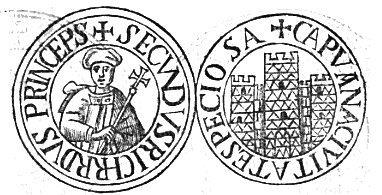|
Robert, Count Of Caiazzo
Robert (died 1116) was a south Italian nobleman who ruled the counties of Airola, Alife, Campania, Alife, Caiazzo, Sant'Agata dei Goti, Sant'Agata and Telese from 1088 until his death. He was the List of Princes of Capua, regent of Capua in 1090–93, and was effectively independent of any lord after 1105. He was a major patron of churches and abbeys, and also commissioned several books. Family Born in southern Italy, Robert belonged to the second generation of the Italo-Norman nobility. He belonged to a cadet branch of the Drengot family; the senior line had ruled the Principality of Capua since 1058. Robert's father, Ranulf I of Caiazzo, Rainulf I, received several counties in the north of the principality from his cousin, Prince Jordan I of Capua, Jordan I, in 1078. These counties had been confiscated from their Lombards, Lombard rulers following a major revolt against Norman rule in 1063–65. In a charter of 4 July 1066, Jordan I and his father, Richard I of Capua, Richard I, r ... [...More Info...] [...Related Items...] OR: [Wikipedia] [Google] [Baidu] |
Sant'Agata De' Goti (7)
Sant'Agata may refer to: People * Agatha of Sicily ( it, Sant'Agata), an Italian Christian Saint Places of Italy ;Municipalities (''comuni'') * Sant'Agata Bolognese, in the Province of Bologna * Sant'Agata de' Goti, in the Province of Benevento * Sant'Agata del Bianco, in the Province of Reggio Calabria * Sant'Agata di Esaro, in the Province of Cosenza * Sant'Agata di Militello, in the Province of Messina * Sant'Agata di Puglia, in the Province of Foggia * Sant'Agata Fossili, in the Province of Alessandria * Sant'Agata Feltria, in the Province of Rimini * Sant'Agata li Battiati, in the Province of Catania * Sant'Agata sul Santerno, in the Province of Ravenna * Tovo di Sant'Agata, in the Province of Sondrio ;Civil parishes (''frazioni'') * Sant'Agata (Villanova sull'Arda), Sant'Agata, in the municipality of Villanova sull'Arda (PC); seat of the ''Villa Verdi'' * Sant'Agata Irpina, in the municipality of Solofra (AV) * Sant'Agata Martesana, in the municipality of Cassina de' Pecchi ... [...More Info...] [...Related Items...] OR: [Wikipedia] [Google] [Baidu] |
Richard II Of Capua
Richard II (died 1105/06), called ''the Bald'', was the count of Aversa and the prince of Capua from 1090 or 1091. He was under the guardianship of Count Robert of Caiazzo until he came of age in 1093. The eldest son and successor of Jordan I of Capua and Gaitelgrima, daughter of Prince Guaimar IV of Salerno, he was named after his grandfather, Richard I of Capua. While digressing on this impressive lineage, the chronicler William of Apulia in his ''The Deeds of Robert Guiscard'' says that he "though now only a young man, already shows courage worthy of an adult." He succeeded to his father's dominions at a very young age and immediately he and his family were thrown out of their city by the capricious Capuans. The counts of Aquino rose in rebellion and attacked Soria, defended by Richard's uncle, Jonathan, Count of Carinola. Richard was an exile for the next seven years (during which a Lombard named Lando IV reigned) until, upon reaching his majority, he requested the aid ... [...More Info...] [...Related Items...] OR: [Wikipedia] [Google] [Baidu] |
Santa Maria In Cingla
Santa Claus, also known as Father Christmas, Saint Nicholas, Saint Nick, Kris Kringle, or simply Santa, is a legendary figure originating in Western Christian culture who is said to bring children gifts during the late evening and overnight hours on Christmas Eve of toys and candy or coal or nothing, depending on whether they are "naughty or nice". In the legend, he accomplishes this with the aid of Christmas elves, who make the toys in his workshop, often said to be at the North Pole, and flying reindeer who pull his sleigh through the air. The modern figure of Santa is based on folklore traditions surrounding Saint Nicholas, the English figure of Father Christmas and the Dutch figure of ''Sinterklaas''. Santa is generally depicted as a portly, jolly, white-bearded man, often with spectacles, wearing a red coat with white fur collar and cuffs, white-fur-cuffed red trousers, red hat with white fur, and black leather belt and boots, carrying a bag full of gifts for childr ... [...More Info...] [...Related Items...] OR: [Wikipedia] [Google] [Baidu] |

